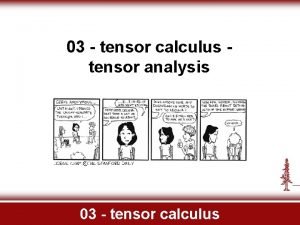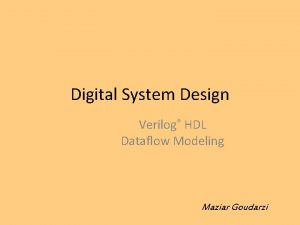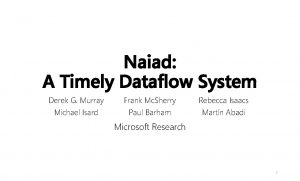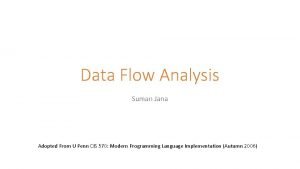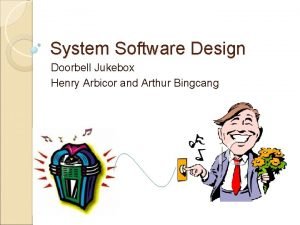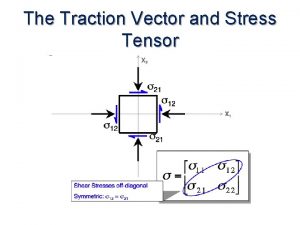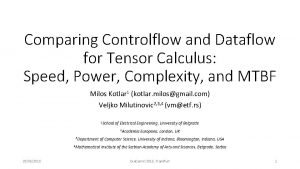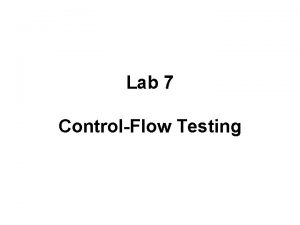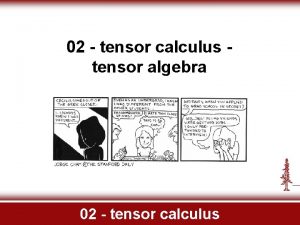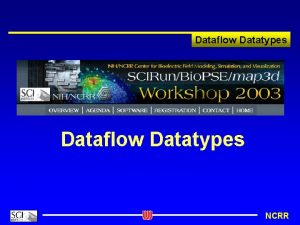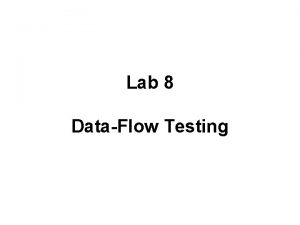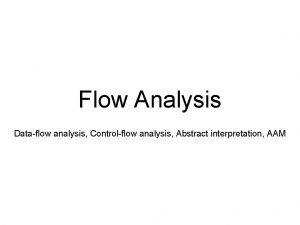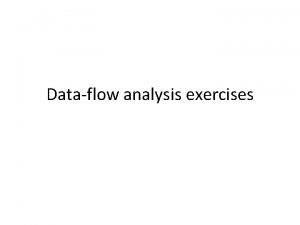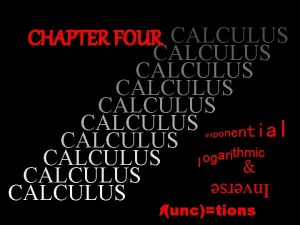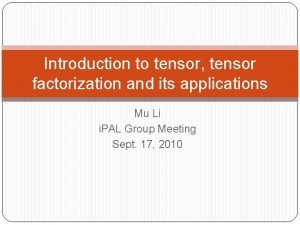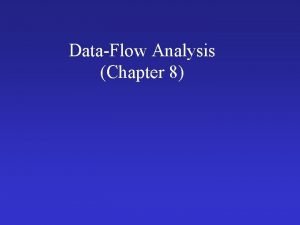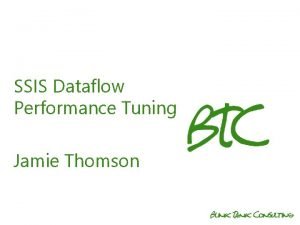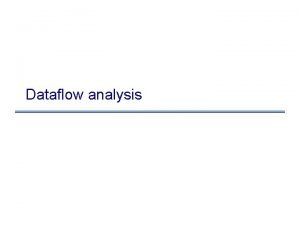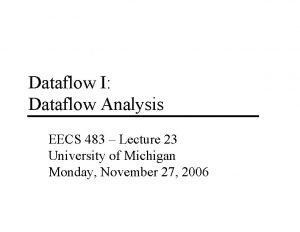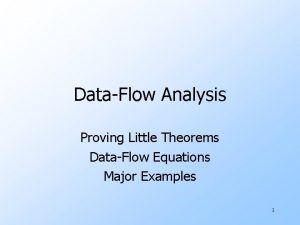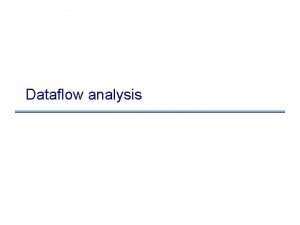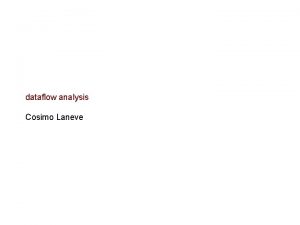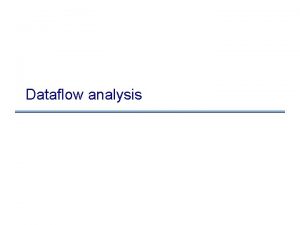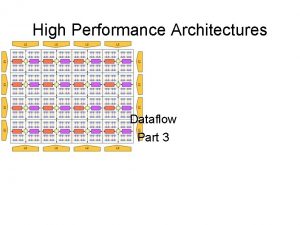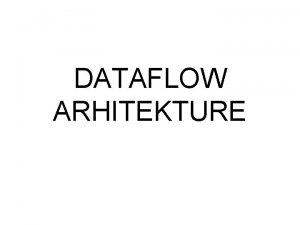Comparing Controlflow and Dataflow for Tensor Calculus Speed

































































- Slides: 65

Comparing Controlflow and Dataflow for Tensor Calculus: Speed, Power, Complexity, and MTBF Milos Kotlar 1 (kotlar. milos@gmail. com) Veljko Milutinovic 2, 3, 4 (vm@etf. rs) 1 School of Electrical Engineering, University of Belgrade 2 Academia 3 Department of Computer Science, University of Indiana, Bloomington, Indiana, USA 4 Mathematical 28/06/2018 Europaea, London, UK Institute of the Serbian Academy of Arts and Sciences, Belgrade, Serbia Exa. Comm 2018, Frankfurt 1

Data is growing faster than ever before • By the year 2020, volume of big data will increase from 10 zettabytes, to roughly 40 zettabyte 2

Data is growing faster than ever before • More data has been created in a past few years, than in the entire previous digital history 3

Data is a new oil • At the moment, less than 0. 5% of all data is ever analysed 4

Machine learning algorithms • Image recognition Elephant • Speech recognition Which place to visit in Frankfurt? • Text recognition • Image captioning My name is Milos Mein Name ist Milos “A person riding a motorcycle on a dirt road” 5

Most of machine learning algorithms are based on the tensor calculus 6

Tensors Calculus • Tensors are a multi-dimensional objects • Following natural sciences have found interest in tensor calculus: • • Civil engineering Physics Chemistry Software engineering 7

Tensors in civil engineering Tensor is an object that operates on a vector to produce another vector 0 th order tensor is scalar 1 st order tensor is vector (3 x 1) 2 nd order tensor (3 x 3) 3 rd order tensor (3 x 3 x 3) 8

Tensors in physics • Deformation tensors - deformation may be caused by external loads, body forces, chemical reactions, or changes in temperature • Stress • Strain • Moment of inertia • Identity 9

Tensors in chemistry • Used in quantum-mechanical observables of molecular systems • Real-space electronic structure calculation • Computing a wave functions 10

Tensors in software engineering • Tensors are high dimensional generalizations of matrices • Machine learning uses tensors in a many algorithms, such as: • Neural networks - for describing relations between neurons in a network • Computer vision - for storing valuable data and correlations between • Natural language processing - for estimating parameters of latent variable models 11

Image is a 3 rd order tensor 12

Video is a 4 th order tensor 13

Facial images database is a 6 th order tensor 14

The big data analysis • The big analysis mostly involves machine learning algorithms, which extract important information from data • The big data applications are taking effort to break the zetta-scale barrier (1021) • The main challenge is finding a way to process such big quantities of data 15

The big data analysis • The ratio of data volume increase is higher than the ratio of processing power increase • Most of the existing approaches are dissipating enormous amount of electrical power, by solving big data problems • Conventional microprocessor technology based on the control-flow paradigm has been increasing the clock rate aligned with the Moore's Law, and thus, the processing power has been improved 16

Moore’s Law • The silicon technology hit a wall, since power dissipation of silicon technology reached its technological limits • According to Moore’s Law, the standard microprocessor technology has hit the wall 17

40 years of microprocessor trend data 18

High-performance computing • The end of Moore's Law leads to the several approaches for solving this problem • The development of high-performance computing systems utilizes other alternative architectural principles, such as the dataflow paradigm 19

Google TPU Dataflow 20

The dataflow paradigm • The dataflow paradigm introduces computing in space where computations are placed dimensionally on a chip • Such an approach perfectly fits when execution time is not a prime concern, to save space and energy, and with limited space and/or power resources • For big data algorithms, the dataflow paradigm can achieve acceleration consuming much less electrical power 21

Conditions for the dataflow paradigm • • Over 95% of the algorithm run-time has to be in loops Acceleration depends on level of data reusability inside the loops • • Suitable for data streaming Latency before the first result is computed • • Presents a new programming model Requires programming effort to accelerate an algorithm 22

Maxeler dataflow architecture 23

Controlflow vs. dataflow • Controlfow: • Computing in time • Number of transistors: ~ 1 B (1, 000, 000) • Clock rate: ~4 GHz • Dataflow: • Computing in space • Number of transistors: ~ 100 M (100, 000) • Clock rate: ~200 MHz 24

Why is dataflow so much faster? Multi. Core/Many. Core Data. Flow Machine Level Code Gate Transfer Level 25

Why are electricity bills so small? controlflow dataflow 26

Why is the transistor count so small? controlflow dataflow Data Processing Process Control 27

CPU Tensors 28

Tensor operations 29

Tensor operations on the dataflow paradigm • Arithmetic changes • Modifying input data choreography • Utilizing internal pipelines • Utilizing on-chip/off-chip memory • Low precision computations • Data serialization (rowwise/columnwise) 30

Tensor addition • An operation of adding two tensors, by adding the corresponding elements: • As 99% of the execution time is spent in loops, the entire algorithm could be migrated to the accelerator 31

Tensor addition • The host program sends tensors in row-wise order to the dataflow engine (DFE), and waits for the result • Control-flow loops are unrolled in the execution graph • Elements of tensors flow through pipelines and compute entire row of a new tensor simultaneously 32

Tensor addition 33

Tensor addition 34

Low precision computation • The dataflow architecture efficiently computes bitwise operations 35

Resource allocation 36

Tensor transpose • An operator which flips a tensor over its diagonal • Elements in a tensor have its own pipelines placed in the transposed order, without any arithmetic units • If the host sends chunks of a tensor to the DFE, or a tensor is too big for streaming, the on-chip memory could be used 37

Stream offset 38

Tensor transpose • Using the stream offsets, the DFE dynamically calculates the position of the next element 39

Tree reduction Original graph Final graph 40

Tensor composition • Tensor composition is a basic operation in linear algebra, and as such has numerous applications in many areas of mathematics, physics, and engineering • The DFE receives entire tensors and produces a new tensor simultaneously 41

Tensor composition 42

Tensor inverse • Algorithms used for calculating inversion of a tensor: • LU decomposition • Cholesky decomposition • The LU decomposition refers to the factorization of a tensor, with proper row and column permutations, into two factors, a lower triangular tensor L and an upper triangular tensor U 43

Tensor inverse • The dataflow implementation could be divided in two phases: • LU/Cholesky decomposition • Computing the inverse of a tensor • When the first phase is done, a new tensor arrives at the beginning of the first phase • Switching to low precision computations, the performance could be improved 44

Tensor inverse 45

Example of SLi. C interface 46

Primary and principal invariants • Invariants of a tensor are coefficients of the characteristic polynomial of a tensor: • Trace is sum of the diagonal components: • How to find determinant of a tensor? • How to find characteristic polynomial coefficients? 47

Primary and principal invariants • The best approach for finding determinant of a tensor is an factorization method that can iterates fast, such as LU decomposition • The Power iteration algorithm is an eigenvalue algorithm that computes the greatest eigenvalue and corresponding eigenvector, which represent coefficients 48

Primary and principal invariants • The dataflow implementation exploits advantage of the off-chip memory • The dataflow manager orchestrates data movements between DFE, off-chip memory, and the host • In each iteration, the algorithm computes a new eigenvalue 49

Eigenvalues and eigenvectors • Computing eigenvalues and eigenvectors is not a trivial problem • The dataflow implementation for calculating eigenvalues and eigenvectors is based on the QR decomposition • The proposed dataflow solution implements the QR decomposition using two different methods: • Gram-Schmidt method • Householder method 50

Gram-Schmidt method • The Gram-Schmidt is an iterative process that is suitable for the dataflow architecture • The algorithm utilizes advantages of the off-chip memory • The data dependency is acyclic, which means that internal pipelines are fully utilized without data buffering 51

Householder method • Algorithm could be expressed as a transformation that takes a vector and reflects it about some plane or hyperplane • The algorithm performs in-place computations, which utilizes on-chip memory • The DFE receives entire tensor, where each element has its own pipeline 52

Householder method 53

Householder method 54

Spectral decomposition • Spectral decomposition, or sometimes eigendecomposition is a factorization of a tensor into a canonical form • The dataflow implementation of the Jacobi eigen algorithm • The Jacobi eigen algorithm is an iterative method that is based on rotations and could be applied only for real symmetric tensors 55

Spectral decomposition • The dataflow implementation streams data to the off-chip memory • In each iteration, data are retrieved from the off-chip memory, the rotations are computed, and data are streamed back to the memory • When an eigenvector is computed the result is transferred from the off-chip memory the host 56

Spectral decomposition 57

Divergence of a tensor field • Volume density of the outward flux of a vector field from an infinitesimal volume around a given point 58

Divergence of a tensor field • A set of tensors are stored in the on-chip memory • In each iteration new tensor is computed, by utilizing parallel internal pipelines 59

Tensor rank • Gaussian elimination is an algorithm for solving systems of linear equations • Could be used for calculating rank of a tensor using echelon form • In memory row swapping are performed using hardware variables, which flow through parallel pipelines • The performance depends on size of a tensor 60

Tensor rank 61

Performance evaluation 62

Performance evaluation • Performance evaluation is based on the speedup per watt and transistor count, which is more suitable for a theoretical study (contrary to speedup per watt and cubic foot, of interest for empirical studies) • Complex operations, such as tensor decompositions, are suitable for big data and achieve significant performance, compared against the conventional controlflow implementations 63

Performance evaluation • Power dissipation depends on the clock frequency and the number of transistors • Complexity of two paradigms is expressed by the transistor count • The MTBF domain depends a lot on the transistor count, the power dissipation, and the presence of components prone to failure, to name a few 64

Source code • https: //github. com/kotlarmilos/tensorcalculus • Thank you! • kotlar. milos@gmail. com 65
 Tensor analysis
Tensor analysis Data flow modeling in verilog
Data flow modeling in verilog Naiad dataflow
Naiad dataflow Dataflow
Dataflow Dataflow mmc
Dataflow mmc Statement terminator
Statement terminator Comparing distance/time graphs to speed/time graphs
Comparing distance/time graphs to speed/time graphs How to find time with distance and speed
How to find time with distance and speed What is fringe vision when driving
What is fringe vision when driving Speed detection of moving vehicle
Speed detection of moving vehicle Sign convention for vectors
Sign convention for vectors Comparing and contrasting hinduism and buddhism
Comparing and contrasting hinduism and buddhism Kontinuitetshantering i praktiken
Kontinuitetshantering i praktiken Typiska drag för en novell
Typiska drag för en novell Tack för att ni lyssnade bild
Tack för att ni lyssnade bild Vad står k.r.å.k.a.n för
Vad står k.r.å.k.a.n för Varför kallas perioden 1918-1939 för mellankrigstiden
Varför kallas perioden 1918-1939 för mellankrigstiden En lathund för arbete med kontinuitetshantering
En lathund för arbete med kontinuitetshantering Underlag för särskild löneskatt på pensionskostnader
Underlag för särskild löneskatt på pensionskostnader Personlig tidbok
Personlig tidbok Anatomi organ reproduksi
Anatomi organ reproduksi Densitet vatten
Densitet vatten Datorkunskap för nybörjare
Datorkunskap för nybörjare Boverket ka
Boverket ka Mall debattartikel
Mall debattartikel Magnetsjukhus
Magnetsjukhus Nyckelkompetenser för livslångt lärande
Nyckelkompetenser för livslångt lärande Påbyggnader för flakfordon
Påbyggnader för flakfordon Lufttryck formel
Lufttryck formel Publik sektor
Publik sektor I gullregnens månad
I gullregnens månad Presentera för publik crossboss
Presentera för publik crossboss Teckenspråk minoritetsspråk argument
Teckenspråk minoritetsspråk argument Kanaans land
Kanaans land Treserva lathund
Treserva lathund Epiteltyper
Epiteltyper Bästa kameran för astrofoto
Bästa kameran för astrofoto Centrum för kunskap och säkerhet
Centrum för kunskap och säkerhet Verifikationsplan
Verifikationsplan Bra mat för unga idrottare
Bra mat för unga idrottare Verktyg för automatisering av utbetalningar
Verktyg för automatisering av utbetalningar Rutin för avvikelsehantering
Rutin för avvikelsehantering Smärtskolan kunskap för livet
Smärtskolan kunskap för livet Ministerstyre för och nackdelar
Ministerstyre för och nackdelar Tack för att ni har lyssnat
Tack för att ni har lyssnat Referat mall
Referat mall Redogör för vad psykologi är
Redogör för vad psykologi är Stål för stötfångarsystem
Stål för stötfångarsystem Tack för att ni har lyssnat
Tack för att ni har lyssnat Borra hål för knoppar
Borra hål för knoppar Orubbliga rättigheter
Orubbliga rättigheter Standardavvikelse
Standardavvikelse Tack för att ni har lyssnat
Tack för att ni har lyssnat Rita perspektiv
Rita perspektiv Verksamhetsanalys exempel
Verksamhetsanalys exempel Tobinskatten för och nackdelar
Tobinskatten för och nackdelar Toppslätskivling dos
Toppslätskivling dos Gibbs reflekterande cykel
Gibbs reflekterande cykel Egg för emanuel
Egg för emanuel Elektronik för barn
Elektronik för barn Plagg i gamla rom
Plagg i gamla rom Strategi för svensk viltförvaltning
Strategi för svensk viltförvaltning Kung som dog 1611
Kung som dog 1611 Indikation för kejsarsnitt på moderns önskan
Indikation för kejsarsnitt på moderns önskan Ro i rom pax
Ro i rom pax Tack för att ni lyssnade
Tack för att ni lyssnade
